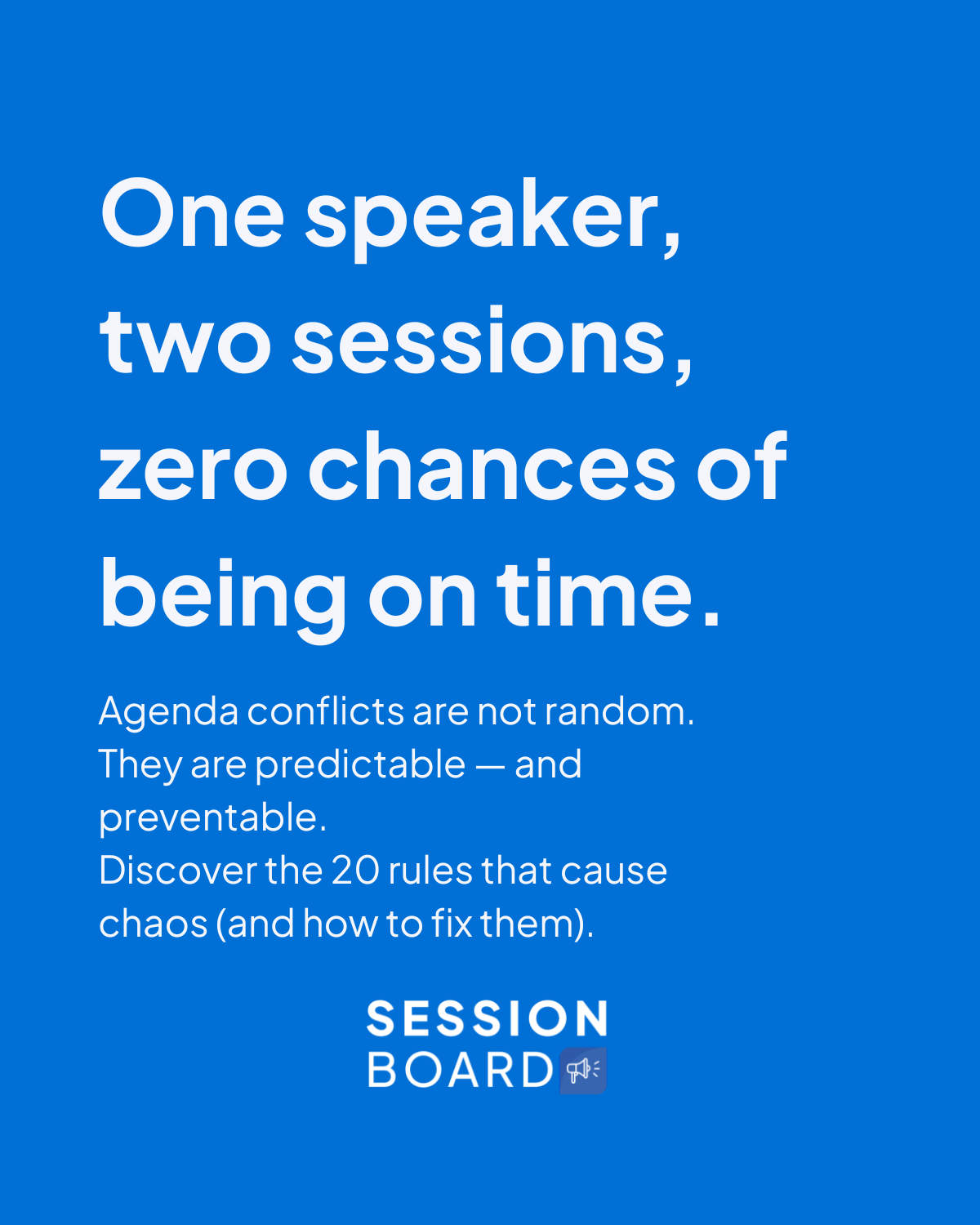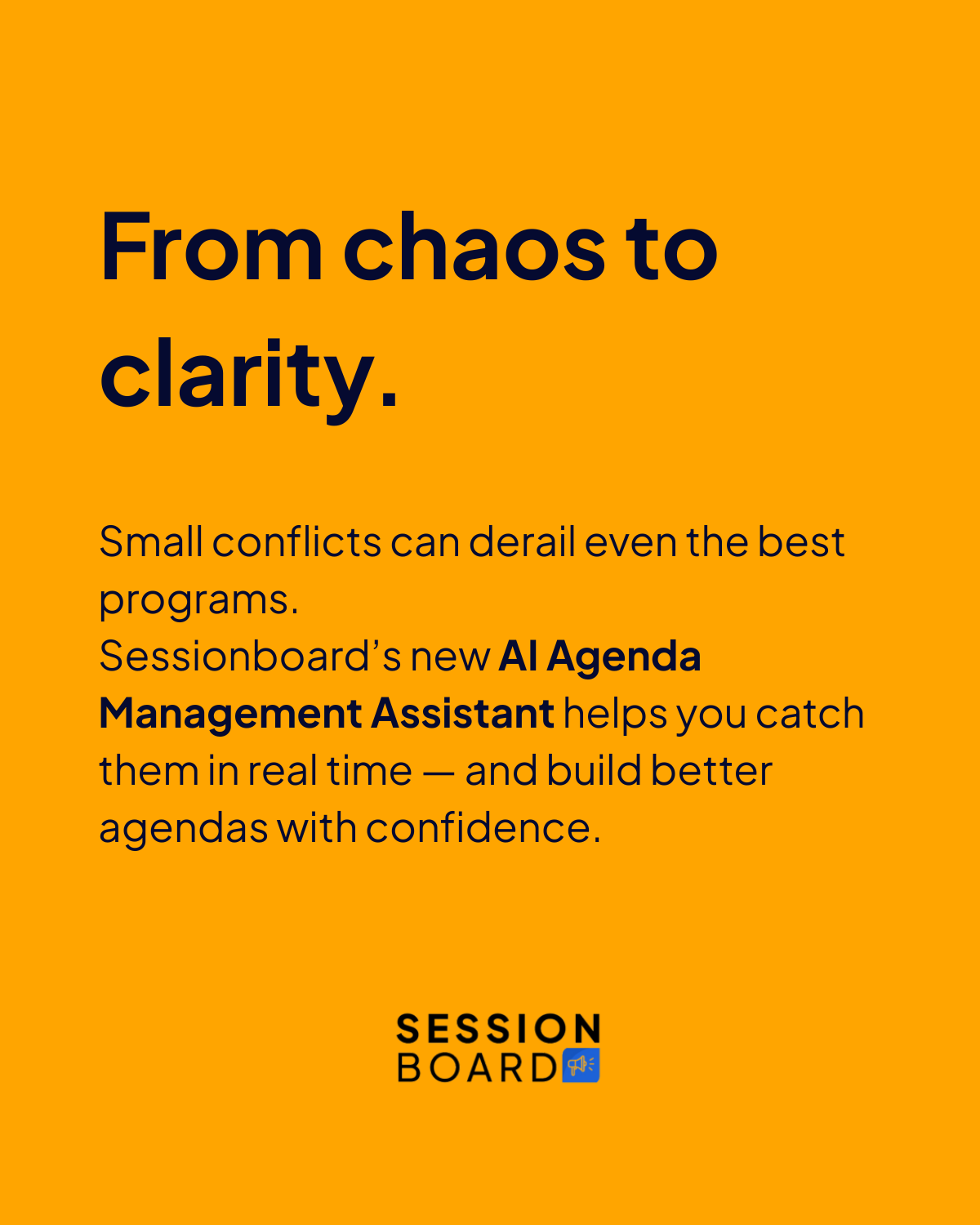20 Agenda Requirements That Love to Create Conflicts
The Domino Effect of Event Agendas
The Domino Effect of Event Agendas
Every event planner knows that building a great agenda is only half the battle. The real challenge is keeping everything from colliding once the pieces start moving.
A speaker asks to shift their time. A sponsor wants a better slot. A room setup runs long. Each small change might seem harmless on its own — until it triggers a chain reaction that sends the rest of your schedule into disarray.
The irony is that these conflicts rarely come out of nowhere. They tend to follow familiar patterns. The same details, rules, and dependencies trip up even the most experienced teams because they are hard to track, hard to visualize, and easy to overlook in the rush of planning.
That is why many events end up in a constant loop of checking, adjusting, and hoping nothing breaks. Schedules are rebuilt again and again, not because the content is bad, but because the workflows behind them are disconnected.
The good news? Most of these problems can be predicted. And once you can predict them, you can prevent them.
In this article, we break down twenty of the most common agenda requirements that cause friction for event teams — and how modern tools like Sessionboard’s AI Agenda Management Assistant help you identify and resolve them before they turn into chaos.
By understanding where conflicts come from, you can plan with more control, build smoother programs, and finally escape the endless cycle of spreadsheet firefighting.
Two sessions, one speaker. It happens all the time, especially when a popular speaker appears on panels, breakouts, or workshops across multiple tracks. Without a single source of truth, overlaps slip through until the last minute, when schedules are locked and fixes are painful.
How to stay ahead: Use structured speaker data that syncs across tracks and events. Let your agenda system flag any double-booking before it reaches the live program.
When two sessions cover the same theme, the audience splits and both sessions suffer. The problem often begins with siloed review committees or multiple planners approving similar proposals.
How to stay ahead: Tag sessions by theme and have AI highlight duplicates or overlapping subjects early in the process.
Sponsors are essential, but they often have specific requests — prime slots, high-traffic rooms, or visibility near headliners. Those requests can easily disrupt your content flow.
How to stay ahead: Apply structured rules for sponsor tiers so sessions are automatically distributed across days and tracks without overtaking key content.
A session that pulls a big crowd but lands in a small room quickly becomes a logistical nightmare. Attendees standing in doorways or turned away reflect poorly on your event’s planning.
How to stay ahead: Use attendance forecasts or historical data to match session type and audience size to the right room automatically.
Back-to-back sessions may look efficient on paper, but A/V transitions and room resets always take time. Skipping that buffer leads to cascading delays.
How to stay ahead: Build setup and teardown buffers directly into your scheduling logic so AI blocks time automatically between sessions.
Hybrid and global events still battle one of the oldest scheduling mistakes: the wrong time zone. A single misalignment can cause missed speakers and confused attendees.
How to stay ahead: Use a central scheduling system that syncs all time zones automatically, removing guesswork from global coordination.

When speakers or VIPs need to move between venues, even short delays can cause major disruptions. Without travel time built into your plan, you end up chasing people through hallways.
How to stay ahead: Create travel buffer rules in your agenda management system so the AI flags sessions that ignore realistic transition times.
Some tracks end up overloaded while others feel empty. This imbalance often comes from uneven approvals or a lack of visibility into the full program view.
How to stay ahead: Use automated balance checks that distribute sessions evenly by topic, format, or region.
Putting five panels or workshops in the same time slot drains energy from both speakers and attendees.
How to stay ahead: Create format variety rules that ensure each block includes a healthy mix of styles, pacing, and engagement levels.
When different teams upload similar session proposals with different titles, it is easy to end up with duplicates. They waste space and confuse attendees.
How to stay ahead: Use AI-powered content matching to identify and merge duplicate submissions before scheduling.
Sessions that compete with lunch or receptions usually lose. Overlaps between programming and meals lead to empty seats, frustrated speakers, and disrupted flow.
How to stay ahead: Build global “no session” blocks into your agenda so meal and networking times are protected by default.
A live demo with booming sound next to a quiet fireside chat? A guaranteed distraction. Physical proximity matters just as much as timing.
How to stay ahead: Tag rooms by noise level and let your scheduling logic prevent high-volume sessions from sitting side by side.
When two headline sessions overlap, attendees are forced to choose — and both sessions lose audience share.
How to stay ahead: Use conflict detection to protect keynote slots as “non-compete” sessions and alert planners before any overlap occurs.
Tracking speaker diversity across gender, background, or geography is essential but hard to manage when data lives in spreadsheets.
How to stay ahead: Use structured speaker profiles and filters to track representation metrics as you build your agenda, not after it is done.
Multiple committees or departments managing different parts of the program often leads to double-booked rooms or missing slots.
How to stay ahead: Centralize agenda ownership in one connected platform where everyone works from the same live data.
Mixing 30-, 45-, and 90-minute sessions without adjusting the overall structure breaks time blocks and creates ripple effects through the entire day.
How to stay ahead: Set flexible time templates so the system adjusts start and end times automatically based on session duration.
Two competing brands presenting at the same time is awkward for both and can even upset sponsors.
How to stay ahead: Tag sessions by company or sponsor and apply conflict rules that prevent overlapping appearances.
When one session builds on another, a last-minute reorder can confuse attendees and break the learning flow.
How to stay ahead: Use dependency logic that keeps related sessions connected even as the rest of the schedule changes.
Predicting which sessions will draw the largest crowds is guesswork without data. A packed session in a small room is frustrating for everyone.
How to stay ahead: Use historical metrics or registration trends to let AI suggest better room assignments or repeat high-demand sessions.
No matter how experienced the team, things slip through. One missed checkbox or version conflict can cause hours of rework.
How to stay ahead: Automate the checks that humans should not have to do manually. Let AI monitor the fine details while your team focuses on strategy.

Each of these twenty conflicts might look small on its own, but together they can derail even the most carefully built program. Every one of them represents a moment where data, timing, and communication need to align, and where manual coordination usually falls short.
That is exactly why we built AI Agenda Management, the newest addition to Sessionboard’s suite of tools for event content teams.
This feature turns complex scheduling logic into simple, reusable rules that prevent problems before they happen.
It checks your agenda in real time, flags potential issues instantly, and gives you visibility across every moving part; speakers, sponsors, rooms, tracks, and time blocks.
The result is a program that runs with precision instead of pressure. Your team spends less time firefighting and more time shaping meaningful experiences for attendees.
Agenda chaos is not a sign of hard work. It is a sign that your tools have not caught up with the complexity of modern events.
With Sessionboard’s AI Agenda Management Assistant, that changes.